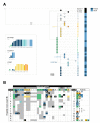Nosocomial Outbreak of SARS-CoV-2 in a "Non-COVID-19" Hospital Ward: Virus Genome Sequencing as a Key Tool to Understand Cryptic Transmission
- PMID: 33916205
- PMCID: PMC8065743
- DOI: 10.3390/v13040604
Nosocomial Outbreak of SARS-CoV-2 in a "Non-COVID-19" Hospital Ward: Virus Genome Sequencing as a Key Tool to Understand Cryptic Transmission
Abstract
Dissemination of severe acute respiratory syndrome coronavirus 2 (SARS-CoV-2) in healthcare institutions affects both patients and health-care workers (HCW), as well as the institutional capacity to provide essential health services. Here, we investigated an outbreak of SARS-CoV-2 in a "non-COVID-19" hospital ward unveiled by massive testing, which challenged the reconstruction of transmission chains. The contacts network during the 15-day period before the screening was investigated, and positive SARS-CoV-2 RNA samples were subjected to virus genome sequencing. Of the 245 tested individuals, 48 (21 patients and 27 HCWs) tested positive for SARS-CoV-2. HCWs were mostly asymptomatic, but the mortality among patients reached 57.1% (12/21). Phylogenetic reconstruction revealed that all cases were part of the same transmission chain. By combining contact tracing and genomic data, including analysis of emerging minor variants, we unveiled a scenario of silent SARS-CoV-2 dissemination, mostly driven by the close contact within the HCWs group and between HCWs and patients. This investigation triggered enhanced prevention and control measures, leading to more timely detection and containment of novel outbreaks. This study shows the benefit of combining genomic and epidemiological data for disclosing complex nosocomial outbreaks, and provides valuable data to prevent transmission of COVID-19 in healthcare facilities.
Keywords: COVID-19; SARS-CoV-2; contact tracing; genome sequencing; healthcare institution; nosocomial outbreak.
Conflict of interest statement
The authors declare no conflict of interest.
Figures


Similar articles
-
Overlapping of Independent SARS-CoV-2 Nosocomial Transmissions in a Complex Outbreak.mSphere. 2021 Aug 25;6(4):e0038921. doi: 10.1128/mSphere.00389-21. Epub 2021 Aug 4. mSphere. 2021. PMID: 34346709 Free PMC article.
-
Genomic and healthcare dynamics of nosocomial SARS-CoV-2 transmission.Elife. 2021 Mar 17;10:e65453. doi: 10.7554/eLife.65453. Elife. 2021. PMID: 33729154 Free PMC article.
-
Whole-genome Sequencing to Track Severe Acute Respiratory Syndrome Coronavirus 2 (SARS-CoV-2) Transmission in Nosocomial Outbreaks.Clin Infect Dis. 2021 Jun 1;72(11):e727-e735. doi: 10.1093/cid/ciaa1433. Clin Infect Dis. 2021. PMID: 32954414 Free PMC article.
-
Nosocomial Outbreak of SARS-CoV-2 in a Hospital Ward during the Omicron Variant-Dominant Wave with a Review of the Relevant Literature.Jpn J Infect Dis. 2024 Sep 19;77(5):253-259. doi: 10.7883/yoken.JJID.2023.464. Epub 2024 May 31. Jpn J Infect Dis. 2024. PMID: 38825458 Review.
-
Nosocomial transmission and outbreaks of coronavirus disease 2019: the need to protect both patients and healthcare workers.Antimicrob Resist Infect Control. 2021 Jan 6;10(1):7. doi: 10.1186/s13756-020-00875-7. Antimicrob Resist Infect Control. 2021. PMID: 33407833 Free PMC article. Review.
Cited by
-
Transmission visualizations of healthcare infection clusters: A scoping review.Antimicrob Steward Healthc Epidemiol. 2022 Jun 15;2(1):e92. doi: 10.1017/ash.2022.237. eCollection 2022. Antimicrob Steward Healthc Epidemiol. 2022. PMID: 36483443 Free PMC article.
-
Proposed new definition for hospital-acquired SARS-CoV-2 infections: results of a confirmatory factor analysis.Antimicrob Steward Healthc Epidemiol. 2024 Sep 9;4(1):e125. doi: 10.1017/ash.2024.371. eCollection 2024. Antimicrob Steward Healthc Epidemiol. 2024. PMID: 39257431 Free PMC article.
-
Epidemiological data and genome sequencing reveals that nosocomial transmission of SARS-CoV-2 is underestimated and mostly mediated by a small number of highly infectious individuals.J Infect. 2021 Oct;83(4):473-482. doi: 10.1016/j.jinf.2021.07.034. Epub 2021 Jul 28. J Infect. 2021. PMID: 34332019 Free PMC article.
-
Molecular epidemiology of SARS-CoV-2 genome sentinel surveillance in commercial COVID-19 testing sites targeting asymptomatic individuals during Japan's seventh epidemic wave.Sci Rep. 2024 Sep 9;14(1):20950. doi: 10.1038/s41598-024-71953-8. Sci Rep. 2024. PMID: 39251760 Free PMC article.
-
On-demand, hospital-based, severe acute respiratory coronavirus virus 2 (SARS-CoV-2) genomic epidemiology to support nosocomial outbreak investigations: A prospective molecular epidemiology study.Antimicrob Steward Healthc Epidemiol. 2023 Mar 8;3(1):e45. doi: 10.1017/ash.2023.119. eCollection 2023. Antimicrob Steward Healthc Epidemiol. 2023. PMID: 36960087 Free PMC article.
References
-
- World Health Organization (WHO) Coronavirus Disease (COVID-19) Weekly Epidemiological Update 8 December 2020. [(accessed on 13 December 2020)]; Available online: https://www.who.int/emergencies/diseases/novel-coronavirus-2019/situatio....
-
- World Health Organization (WHO) Infection Prevention and Control During Health Care When Coronavirus Disease (COVID-19) is Suspected or Confirmed. Geneva: World Health Organization. [(accessed on 11 October 2020)];2020 Available online: https://apps.who.int/iris/rest/bitstreams/1284718/retrieve.
Publication types
MeSH terms
Substances
LinkOut - more resources
Full Text Sources
Other Literature Sources
Medical
Miscellaneous

